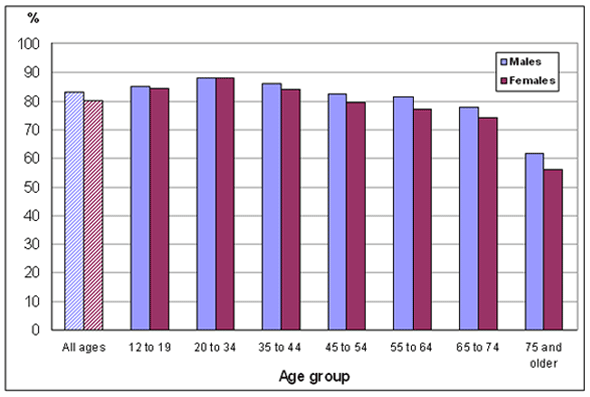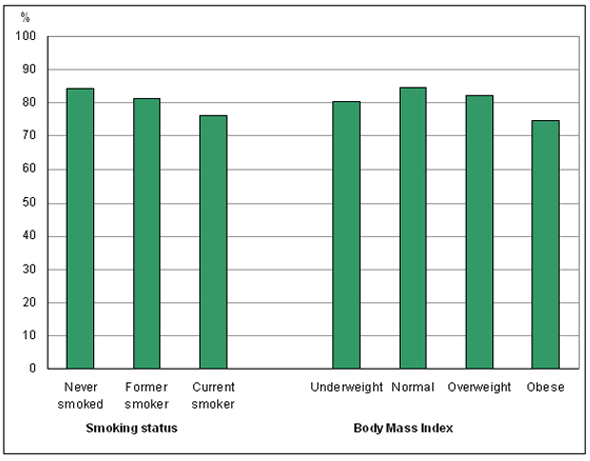Functional Health, 2009
Archived Content
Information identified as archived is provided for reference, research or recordkeeping purposes. It is not subject to the Government of Canada Web Standards and has not been altered or updated since it was archived. Please "contact us" to request a format other than those available.

The Health Utility Index Mark 3 (HUI3), developed at McMaster University, measures a person's functional health using eight attributes: vision, hearing, speech, mobility, dexterity, feelings, cognition and pain. Each attribute ranges from no impairment to severely impaired. For example, mobility ranges from walking without difficulty to not being able to walk at all. Intermediate levels of mobility are walking with difficulty, needing walking aids and needing a wheelchair.
An overall score of 0.8 to 1.0 is considered to be 'good to full' functional health; scores below 0.8 are considered to indicate 'moderate to poor' functional health.
In 2009, 81.6% of Canadians aged 12 and older were in good to full functional health, based on this index.
The percentage with good to full functional health was highest in the age range from 20 to 34—88.0% for both males and females. This percentage generally decreased moving up the age ranges, except that ages 45 to 54 and 55 to 64 were not significantly different from each other.
Overall, 83.0% of males were in good to full functional health, compared with 80.3% of females. There were no significant differences in the sexes aged 12 to 54, but at ages 55 and older more males than females showed good to full functional health (Chart 1).
Chart 1
Percentage with good to full functional health, by age group and sex, household population aged 12 years and older, Canada, 2009

Source: Canadian Community Health Survey, 2009.
Canadians who had never smoked were more likely to have good to full functional health than those who were former smokers (84.4% versus 81.3%). In turn, former smokers were more likely to have a Health Utility Index over 0.8 than those who were current smokers (76.4%) (Chart 2).
Body weight is also important to functional health. Canadians of normal weight—based on respondent-reported height and weight and Health Canada guidelines on Body Mass Index (BMI)—were most likely to report good to full functional health; 84.7% reported so. Among overweight Canadians, 82.2% reported good to full functional health, compared with 74.6% of obese Canadians (Chart 2).
Chart 2
Percentage with good to full functional health, by smoking status and Body Mass Index, household population aged 12 years and older, Canada, 2009

Source: Canadian Community Health Survey, 2009.
In Quebec, 85.8% of residents were in good to full functional health—the only province or territory above the national average in 2009. Five provinces were below the national average for good to full functional health: Newfoundland and Labrador, 77.3%; Nova Scotia, 78.3%; New Brunswick, 78.8%; Ontario, 80.0%; and Saskatchewan, 79.4%. People in the other provinces and territories reported rates that were about the same as the national average.
Because of the strong relationship between age and functional health, a province or territory with a disproportionately 'younger' population would be expected to have a functional health rate above the national average. Conversely, a province or territory with an 'older' population should have a functional health rate below the national average. To remove the effect of different age distributions, the rates of good to full functional health were recalculated as if the age groups in each province and territory were the same as at the national level. Based on these age-standardizing calculations, British Columbia joined Quebec as the provinces in which good to full functional health was above the national average. Residents of Prince Edward Island, Saskatchewan, Northwest Territories and Nunavut reported functional health about the same as the national average; residents of all other provinces and territories were less likely to have full to functional health than the national average rate.
References
Feng, Yan, Bernier, Julie, McIntosh, Cameron and Heather Orpana. 2009. "Validation of disability categories derived from Health Utilities Index Mark 3 scores." Health Reports. Vol. 20, no. 2. June. Statistics Canada Catalogue no. 82-003. /bsolc/olc-cel/olc-cel?lang=eng&catno=82-003-X200900210863 (accessed May 10, 2010).
Orpana, Heather, Ross, Nancy, Feeny, David, et al. 2009. "The natural history of health-related quality of life: A 10–year cohort study." Health Reports. Vol. 20, no. 1. March. Statistics Canada Catalogue no. 82-003. /bsolc/olc-cel/olc-cel?lang=eng&catno=82-003-X200900110794 (accessed May 10, 2010).
Data
Additional data from the Canadian Community Health Survey are available from CANSIM table 105–0501.
- Date modified:
